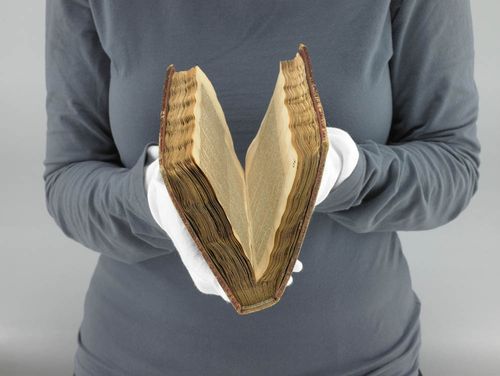Thomas Jefferson’s private text, The Life and Morals of Jesus of Nazareth—colloquially known as the Jefferson Bible—is made up of excerpts from the Four Gospels of the New Testament in Greek, Latin, French and English.
National Museum of American History Displays Thomas Jefferson’s Book, The Life and Morals of Jesus of Nazareth
The Smithsonian’s National Museum of American History will display Thomas Jefferson’s The Life and Morals of Jesus of Nazareth, a remarkable document from the early 19th century. Living at Monticello in retirement following his two terms as President, Jefferson assembled a private text in 1820, often referred to as “The Jefferson Bible.” Cutting excerpts from four translations—English, French, Latin and Greek—of the Four Gospels, Jefferson sought to tell a chronological and distilled version of Jesus’ life and moral teachings. The exhibition “Jefferson’s Bible” will open in the Albert H. Small Documents Gallery Nov. 11 and run through May 28, 2012, and a companion website will be available at http://americanhistory.si.edu/jeffersonbible.
The display will present Jefferson’s handmade and recently meticulously conserved volume, together with two English editions of the New Testament that Jefferson used to excerpt passages, and a copy of the 1904 U.S. Government Printing Office edition of the book. Visitors will be able to explore each page of the bible at a special Web kiosk and view short videos about the book’s history and conservation treatment. “The volume provides an exclusive insight to the religious and moral beliefs of the writer of the Declaration of Independence, the nation’s third President, as well as his position as an important thinker in the Age of Enlightenment,” said Harry Rubenstein, curator at the museum. “The recent specialized treatment ensures that generations to come will be able to study and view this tangible witness to history.”
The conservation treatment and display were made possible with funding from Peter and Rhondda Grant, Brenton Halsey, Albert H. Small, Mr. and Mrs. Charles F. Bryan Jr. and other contributors, as well as federal funds from the Smithsonian’s Collections Care and Preservation Fund.
Professionally bound in rich Morocco leather with gold tooling, this volume—8.25 inches by 5 inches—was not printed but rather constructed more like a scrapbook. Jefferson cut selected passages from printed New Testaments in four languages and glued them onto the front and back of blank folios in four columns to allow easy comparisons between the translations.
Jefferson’s goal in creating this volume was to distill Jesus’ ethical teachings, which he believed provided “the most sublime and benevolent code of morals which has ever been offered to man.” Jefferson fashioned this volume for his own reading and reflection. It was a personal exercise in understanding Jesus’ teachings. The resulting work represented a meeting of Enlightenment thinking, Christian tradition and American Revolutionary thought, as imagined by one of the great thinkers of the era.
Jefferson never published his book, rather intending it to be private reading material and not for a larger audience. He considered his and others’ religious beliefs a private matter that should not be subjected to public scrutiny or government regulation.
The book stayed in Jefferson’s family until the Smithsonian’s librarian purchased it from Carolina Randolph, Jefferson’s great-granddaughter, in 1895. By an act of Congress in 1904, lithographic reproductions of the volume were created for distribution to members of Congress. Once these copies were distributed, no other facsimiles were made.
After nearly 200 years, the book has become fragile. Because of its age and the glue used to adhere the cuttings to the blank paper, the pages were extremely stiff and inflexible, and its tight binding led to cracking and some tearing of the pages, making the book too fragile to display. Conservation treatment was required to reestablish use and to ensure its long-term preservation. The treatment was to clean and stabilize the book, mend damaged pages and rebind the folios into Jefferson’s original cover. This allows the museum to once again safely display the book and provides access for scholarly research to this historic treasure. In addition, the team has constructed a custom protective enclosure to house the bible for long-term storage.
Smithsonian Books has released a full-color, reproduction facsimile, which features introductory essays by museum historians Rubenstein and Barbara Clark Smith, as well as an overview of the conservation treatment by the museum’s book and paper conservator Janice Stagnitto Ellis. Visit www.smithsonianbooks.com.
The Smithsonian Resident Associates will present “Thomas Jefferson’s Personal Guide to a Moral Life,” a special program featuring Thomas Jefferson as portrayed by Bill Barkerof
Colonial Williamsburg, as well as Rubenstein, Clark Smith and Ellis to discuss the history and conservation of the book Nov. 15 at 6:45 p.m. Visit http://residentassociates.org/ticketing/ for more information.
Smithsonian Channel has produced an hour-long documentary that will tell the extraordinary story of Jefferson’s bible and chronicle the intricate conservation work. Jefferson’s Secret Bible premieres February 2012.
“Jefferson’s Bible” is included in a comprehensive Smithsonian website at www.gosmithsonian.com/jefferson that features Smithsonian collections and research about Jefferson.
The National Museum of American History collects, preserves and displays American heritage in the areas of social, political, cultural, scientific and military history. To learn more about the museum, check http://americanhistory.si.edu. For Smithsonian information, the public may call (202) 633-1000, (202) 633-5285 (TTY).
# # #
SI-490-2011
Valeska Hilbig
Melinda Machado
202-633-3129











